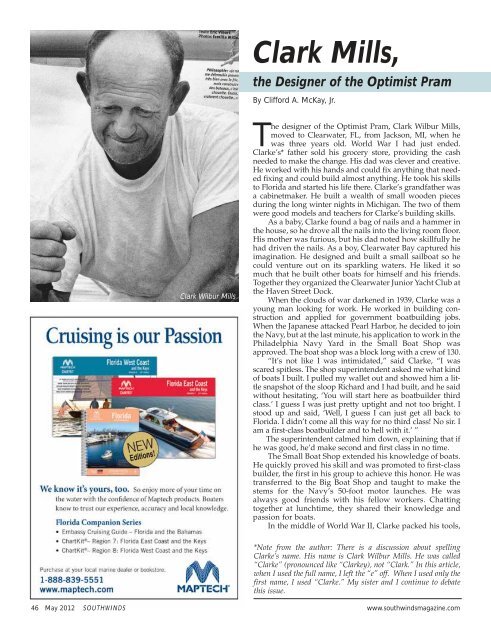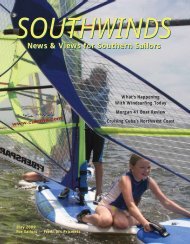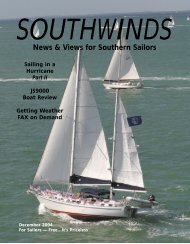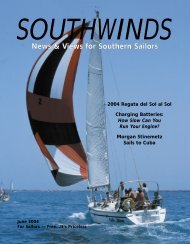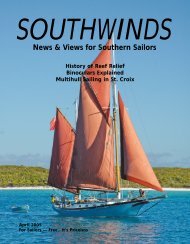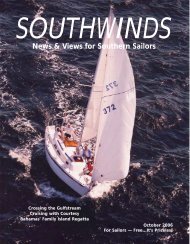Clark Mills,the Designer of the Optimist PramBy Clif<strong>for</strong>d A. McKay, Jr.Clark Wilbur MillsThe designer of the Optimist Pram, Clark Wilbur Mills,moved to Clearwater, FL, from Jackson, MI, when hewas three years old. World War I had just ended.Clarke’s* father sold his grocery store, providing the cashneeded to make the change. His dad was clever and creative.He worked with his hands and could fix anything that neededfixing and could build almost anything. He took his skillsto Florida and started his life there. Clarke’s grandfather wasa cabinetmaker. He built a wealth of small wooden piecesduring the long winter nights in Michigan. The two of themwere good models and teachers <strong>for</strong> Clarke’s building skills.As a baby, Clarke found a bag of nails and a hammer inthe house, so he drove all the nails into the living room floor.His mother was furious, but his dad noted how skillfully hehad driven the nails. As a boy, Clearwater Bay captured hisimagination. He designed and built a small sailboat so hecould venture out on its sparkling waters. He liked it somuch that he built other boats <strong>for</strong> himself and his friends.Together they organized the Clearwater Junior Yacht Club atthe Haven Street Dock.When the clouds of war darkened in 1939, Clarke was ayoung man looking <strong>for</strong> work. He worked in building constructionand applied <strong>for</strong> government boatbuilding jobs.When the Japanese attacked Pearl Harbor, he decided to jointhe Navy, but at the last minute, his application to work in thePhiladelphia Navy Yard in the Small Boat Shop wasapproved. The boat shop was a block long with a crew of 130.“It’s not like I was intimidated,” said Clarke, “I wasscared spitless. The shop superintendent asked me what kindof boats I built. I pulled my wallet out and showed him a littlesnapshot of the sloop Richard and I had built, and he saidwithout hesitating, ‘You will start here as boatbuilder thirdclass.’ I guess I was just pretty uptight and not too bright. Istood up and said, ‘Well, I guess I can just get all back toFlorida. I didn’t come all this way <strong>for</strong> no third class! No sir. Iam a first-class boatbuilder and to hell with it.’ ”The superintendent calmed him down, explaining that ifhe was good, he’d make second and first class in no time.The Small Boat Shop extended his knowledge of boats.He quickly proved his skill and was promoted to first-classbuilder, the first in his group to achieve this honor. He wastransferred to the Big Boat Shop and taught to make thestems <strong>for</strong> the Navy’s 50-foot motor launches. He wasalways good friends with his fellow workers. Chattingtogether at lunchtime, they shared their knowledge andpassion <strong>for</strong> boats.In the middle of World War II, Clarke packed his tools,*Note from the author: There is a discussion about spellingClarke’s name. His name is Clark Wilbur Mills. He was called“Clarke” (pronounced like “Clarkey), not “Clark.” In this article,when I used the full name, I left the “e” off. When I used only thefirst name, I used “Clarke.” My sister and I continue to debatethis issue.46 May 2012 SOUTHWINDS www.southwindsmagazine.com
Mills’ yard in the 1950s, Clearwater BayMarine Ways, Inc. Mills ran the yard withFrank Levinson.left Philadelphia, and moved to the PanamaCanal Zone as a shipwright. He faced newchallenges and continued to increase hisbuilding skills. In his spare time, he built an18-foot sailboat from scraps in order to sail thewaters of the Canal Zone. When the warended, he returned to Clearwater to seewhether or not he could make a living designingand building boats. Whether or not he was a third-classbuilder when he started in Philadelphia, clearly he was nowa first-class boatbuilder.I met Clarke In 1946 when I first discovered sailing. Iwas 11. I’d get off the school bus, walk across the ClearwaterYacht Club grounds to the old fish house shed, a cavernoustin building where in the dark back corner Clark Mills wasbuilding a small 24-foot sailboat. A little light crept inthrough the crazed windows, but the main light was fromtwo small naked bulbs hung over the work. Clarke likedvisiting as he worked. He could maintain a lively conversationwhile his hands deftly crafted the next piece <strong>for</strong> theboat. He loved wood, all species of wood, but especiallyordinary woods like pine, oak, cypress and fir plywood. Heunderstood wood, and it understood him. It responded tohis touch. The result was always smooth curves and tightfittingjoints. He learned from his family to work hard, butalso to take time to play. He described “gunkholing” in asailboat as “sailing down the coast, and when you see someone,or something on shore that interests you, you drop theanchor and go ashore and spend a few days.” As he worked,he had time to talk—talk about sailing and boats, talk aboutbuilding boats, talk about Florida and how it was when hefirst arrived in the 1920s. He was friendly and gregarious.He loved life, and he loved his work.Around us in the old fish house were racing Snipes restingon their trailers. Clarke didn’t race, but he had repairedmany of these boats. When he built a couple of racingSnipes <strong>for</strong> local men, the boats sailed so well that he soonhad orders that would take him more than a year to build. Iasked him about “Mills Snipes.” Had they a flatter keel withless rocker? Did he build them fuller in the bow? Whatmade them sail fast? In his usual modest manner, heanswered, “Shucks, I just try to get them inside the narrowtolerances of class measurements. I’m just glad if they ‘measurein.’ ”He had a great sense of humor and loved to laugh. Heproposed the first movable ballast <strong>for</strong> a sailboat. “You loadthe bilge with turtles. When you tack, they’ll crawl up to thehigh side.”The idea <strong>for</strong> the Optimist Pram started with my father,Major Clif<strong>for</strong>d McKay. His concept came from the Soap BoxDerby, a race <strong>for</strong> small gravity-powered cars. In August of1947, he proposed to the Clearwater Optimist Club a smallsafe, simple boat that a boy could build. It needed to beinexpensive. It should be built of 4’ x 8’ plywood and cost$50. Merchants would sponsor the boat, and every boy andgirl could have one to sail. Dad, who was not a sailor, suggesteda bed sheet <strong>for</strong> the sail. Said Clarke, “I talked him outof the bed sheet.”Clarke said of his design, “I had a little knockaboutrambling about in my head. I lopped off the bow to fit the 4x 8 plywood. It looks a little funny, but it sails real good.”The sprit rig keeps the center of ef<strong>for</strong>t low, which, matchedwith the 3’ 10” beam, provides remarkable stability. Clarketook Dad’s parameters and created the safe, lively, inexpensive,fun-to-sail little boat that took the world by storm.Dad’s original idea was <strong>for</strong> the boys to build their ownboats, but that never happened. For the first boats, ClarkeWhat a concept!It is engineeredto be easily serviced.• Beta Marine supurb propulsionengines using Kubota diesels• From 13.5 to 105 HP including ourfamous Atomic 4 replacements• 150 HP using Iveco diesel• Also available: marine generators up to 30KwBeta Marine US, Ltd.PO Box 5, Arapahoe, NC 28510877-227-2473 • 252-249-2473 • fax 252-249-0049info@betamarinenc.com • www.betamarinenc.com<strong>News</strong> & <strong>Views</strong> <strong>for</strong> <strong>Southern</strong> <strong>Sailors</strong> SOUTHWINDS May 2012 47


